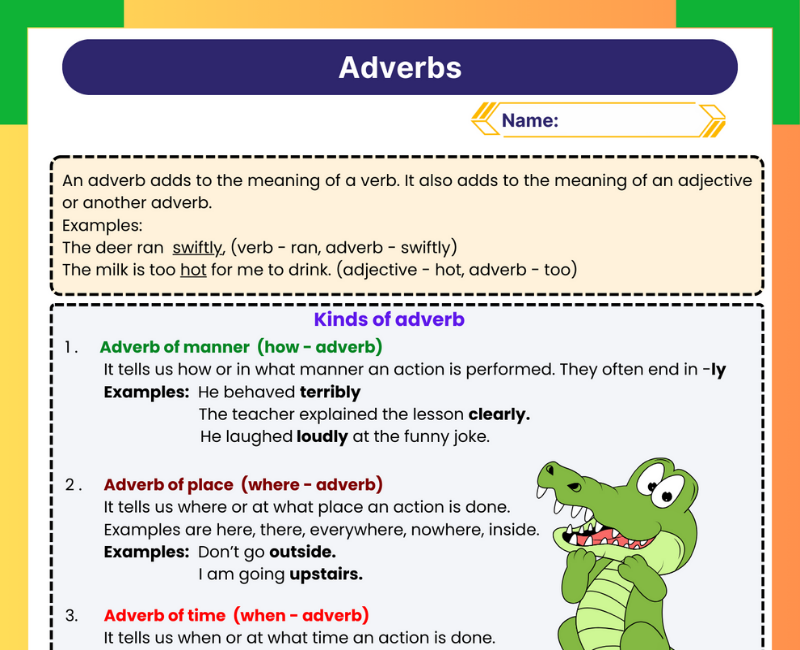Interactive Adverbs Worksheet for Class 5 Students
Are your Class 5 students struggling with adverbs? If so, we have the perfect solution for you! Introducing "Mastering Adverbs: A Fun and Interactive Adverbs Worksheet for Class 5 Students." This engaging and educational resource is designed to help students develop a strong understanding of adverbs while having fun along the way. With this worksheet, students will explore different types of adverbs, such as adverbs of manner, time, place, and frequency.
They will be challenged with exciting exercises and activities that promote active learning and critical thinking. From filling in the blanks with suitable adverbs to creating their own adverb sentences, students will gain a firm grasp on this important part of speech. Not only will this worksheet improve students' knowledge of adverbs, but it will also enhance their writing skills and boost their confidence in using adverbs correctly. By incorporating adverbs into their writing, students will add depth and clarity to their sentences, making their compositions more engaging and impactful. Don't miss out on this valuable resource! Get your students on the path to mastering adverbs and watch their language skills flourish.
In the heart of our grammar resources, you'll find the adverbs worksheet, a comprehensive tool designed to enhance students' understanding of adverbs and their crucial role in sentence construction. Tailored specifically for learners, our worksheet on adverbs covers everything from basic identification to advanced application, including adverbs types exercises that distinguish between adverbs and adjectives. This not only sharpens grammatical accuracy but also enriches writing styles. For educators and students in class 5, our adverbs worksheet for class 5 with answers is a game-changer, offering targeted practice that directly supports the curriculum.
The inclusion of an adverbs worksheet with answers facilitates self-assessment, allowing learners to check their work and understand their mistakes. Furthermore, our adverbs adjectives worksheet provides an excellent opportunity to compare and contrast these two critical parts of speech, deepening students' comprehension. The adverbs worksheet class 5 and the worksheet on adverbs for class 5 are meticulously designed to cater to the educational needs at this pivotal stage of learning, ensuring that each student can confidently use adverbs in their writing. With these resources, mastering adverbs becomes a straightforward and rewarding journey.
What are Adverbs and Why are They Important?
Adverbs are words that modify verbs, adjectives, or other adverbs, providing additional information about how, when, where, and why something happens. They are important because they allow us to add detail and nuance to our sentences, making our communication more precise and informative. By describing the manner, time, place, and reason of actions, adverbs help paint a clearer picture in the listener's or reader's mind, enhancing the overall effectiveness of our language.
Types of Adverbs
There are several types of adverbs, each serving a different purpose in a sentence. These include adverbs of manner (how?), adverbs of time (when?), adverbs of place (where?), adverbs of frequency (how often?), and adverbs of degree (to what extent?). Understanding these categories helps in identifying and using adverbs correctly, enriching our speech and writing.
Examples of Adverbs in Sentences
- Manner: He ran quickly.
- Time: She will call you tomorrow.
- Place: They looked everywhere.
- Frequency: He rarely eats out.
- Degree: She almost finished the project.
These examples demonstrate how adverbs modify verbs to provide more context.
Adverbs of Time and Frequency
Adverbs of time indicate when an action occurs, while adverbs of frequency tell us how often something happens. Examples include "yesterday" (time) and "often" (frequency). These adverbs help sequence events and indicate the regularity of actions, crucial for clear communication.
Adverbs of Manner and Degree
Adverbs of manner describe how an action is performed, and adverbs of degree express the intensity or extent of an action or quality. Words like "slowly" (manner) and "very" (degree) add depth to our descriptions, allowing for more expressive communication.
Adverbs of Place and Direction
These adverbs tell us where an action occurs or in what direction. "Here" (place) and "upstairs" (direction) are examples that orient the action within a physical context, adding clarity to the spatial aspects of our narrative.
Adverbs of Purpose and Reason
Adverbs of purpose explain why something is done, often introduced by "to" in infinitive verbs, or explicitly stated with words like "purposefully." They give insight into the motive behind actions, adding a layer of understanding to statements.
Using Adverbs in Writing
Incorporating adverbs effectively can transform writing from simple to vivid, enhancing the reader's engagement and comprehension. Careful selection and placement of adverbs ensure clarity and prevent ambiguity, enriching the text's descriptive quality.
Conclusion and Interactive Adverbs Worksheet
Understanding and using adverbs is key to developing advanced language skills. An interactive adverbs worksheet can provide practical experience, reinforcing the concepts discussed. Through exercises that challenge the learner to identify, categorize, and use adverbs in context, students can enhance their grasp of how adverbs work to enrich language, making their writing and speech more detailed and dynamic.





